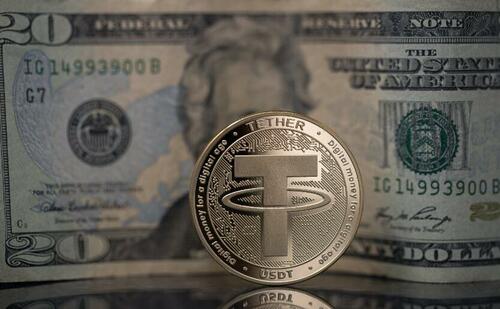Authored by Omid Malekan via Medium,.
Stablecoins aren’t usually funny, but this tale might make you laugh out loud...
Bloomberg columnist Matt Levine recently noted that he feels like Tether will someday be an incredibly interesting story, but he’s not sure what it is.
Here’s one plotline: Tether is the most successful product and company in crypto.
Outside observers keep waiting for someone to shut it down but it keeps winning. Despite a general hostility towards crypto, the US government keeps killing its competitors while paying it billions of dollars in interest. America’s face would like its nose back.
Some people don’t know this, but stablecoins were initially created because crypto exchanges couldn’t get bank accounts.
Their clients wanted a way to trade in and out of dollars or to transfer dollars from one exchange to another to take advantage of arbitrage opportunities. Ergo Tether, founded in 2014 by a sister company to a major exchange. Even the exchanges that had bank accounts benefited from adopting it because unlike virtually any other industry, banks paradoxically only operate 20% of the time (feel free to double check this math).
Tether was the first fiat-backed stablecoin and is now the biggest by a wide margin: 85 billion tokens outstanding, and growing. That’s big, and not just by crypto standards. Its next biggest competitor is a third of its size (and shrinking). Tether is issued by an offshore entity and is famous for operating in the gray-zone of financial regulation. It has been the subject of fantastical (and often moronic) conspiracy theories, usually peddled by Wall Street experts who don’t know the difference between a token and a tomato but don’t let that stop them from predicting its collapse. Some went as far as shorting it, to no avail.
A monkey throwing darts would have made a killing shorting almost any other cryptocoin in the past few years, but these geniuses paid interest to watch it keep the peg.
Anyway - we do know that Tether hasn’t always been upfront about the reserves backing its coin and that at some point they loaned a bunch of money to an affiliate, which wasn’t kosher. But we also know their token has almost never deviated from a buck. It regained the peg surprisingly quickly the few times that it did, creating a wonderful arbitrage opportunity for those who do know the difference between a token and a tomato.
Tellingly, nobody has ever complained about an inability to convert USDT to dollars, a simple fact that should have convinced most of the conspiracy theorists if they were less emotional.
Being more rational would also help them see the more prosaic explanations for why Tether hasn’t been more transparent, like a desire to protect their service providers from unwanted attention.
Tether’s biggest competitor is USDC, issued by a regulated American company called Circle.
Circle’s branding has always pivoted off the opacity of Tether and bragged about a more conservative reserve. But USDC suffered a major depeg earlier this year on account of $3b sitting at Silicon Valley Bank. It may have never recovered if SVB hadn’t been bailed out. But in Circle’s defense, it wouldn’t have had to keep any money at a regional bank if the U.S. government didn’t effectively ban the Too Big to Fail banks from banking crypto firms.
Consider this exhibit A of how the US government has helped Tether win.
In another universe, one where regulators cared more about innovation and progress than protecting incumbents, the big banks would have been ordered to hold stablecoin reserves or maybe even issue their own. But that’s not the universe we live in. So we get the opaque offshore stablecoin that we deserve, and that’s Tether.
Tether’s next biggest competitor was BUSD, a stablecoin issued by a highly regulated New York company called Paxos and white-labeled to Binance.
The US government killed BUSD because it doesn’t like Binance. You could have actually watched the funds flow from a licensed, regulated and onshore issuer to Tether.
Because stablecoins are popular, there are new entrants to the market like PayPal, one of the oldest, biggest and safest FinTechs out there. In that alternative universe where American regulators are sane, PayPal USD would have been embraced by anyone concerned about the integrity of Tether, or the reserve status of the dollar for that matter. Stablecoins aren’t just good for crypto speculators or offshore people who want dollars, they are also good for the US government, on account of their attached reserve, which is mostly composed of Treasury bonds.
So how do American regulators react when a respected and regulated American company issues a product that expands the reach of the dollar while financing our ever-growing deficit? They send it a subpoena. You couldn’t make this stuff up, but then again you don’t have to.
Meanwhile, Tether is laughing all the way to the bank. Not only is the US government helping it grow and grow, it is also paying it billions of dollars a year in interest — Tether is now one of the biggest non-state holders of US government debt. It has no choice but to pocket that income because US securities laws bar stablecoin issuers from paying interest to their holders. The only way around that regulation is by blacklisting American customers, which some of Tether’s newest competitors do. Bad for John and Jennifer, citizens who hold stablecoins and would like to earn interest, but good for Jamie and Jane, TBTF Bank CEOs whose shitty checking accounts are rendered obsolete by interest-bearing dollar tokens.
All of this begs a simple question: why hasn’t the US government killed Tether?
One answer is it might not be able to.
Another one is that killing a company that expands the reach of your currency while financing your debt is like cutting off your own head to spite your adversaries nose.
